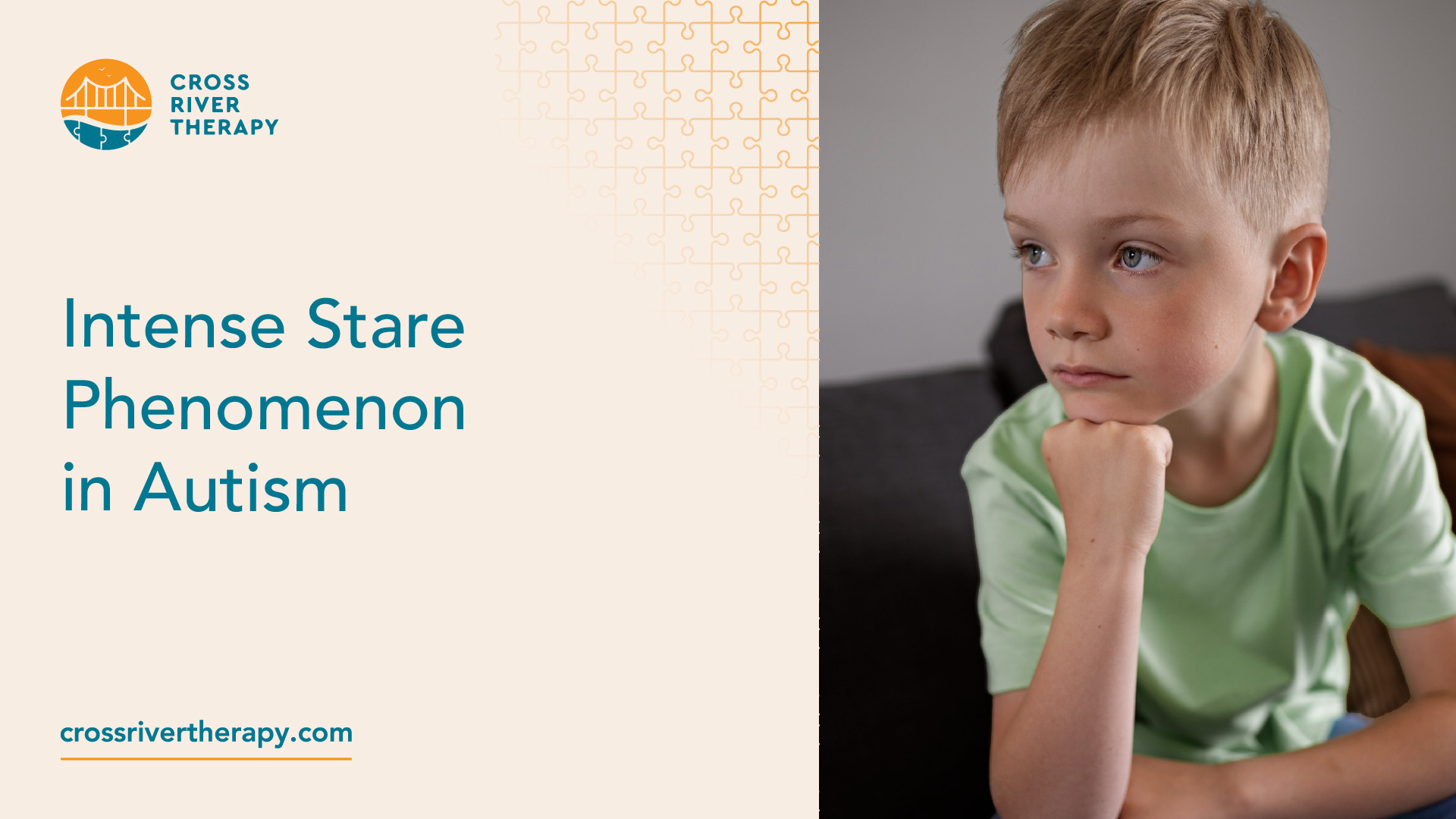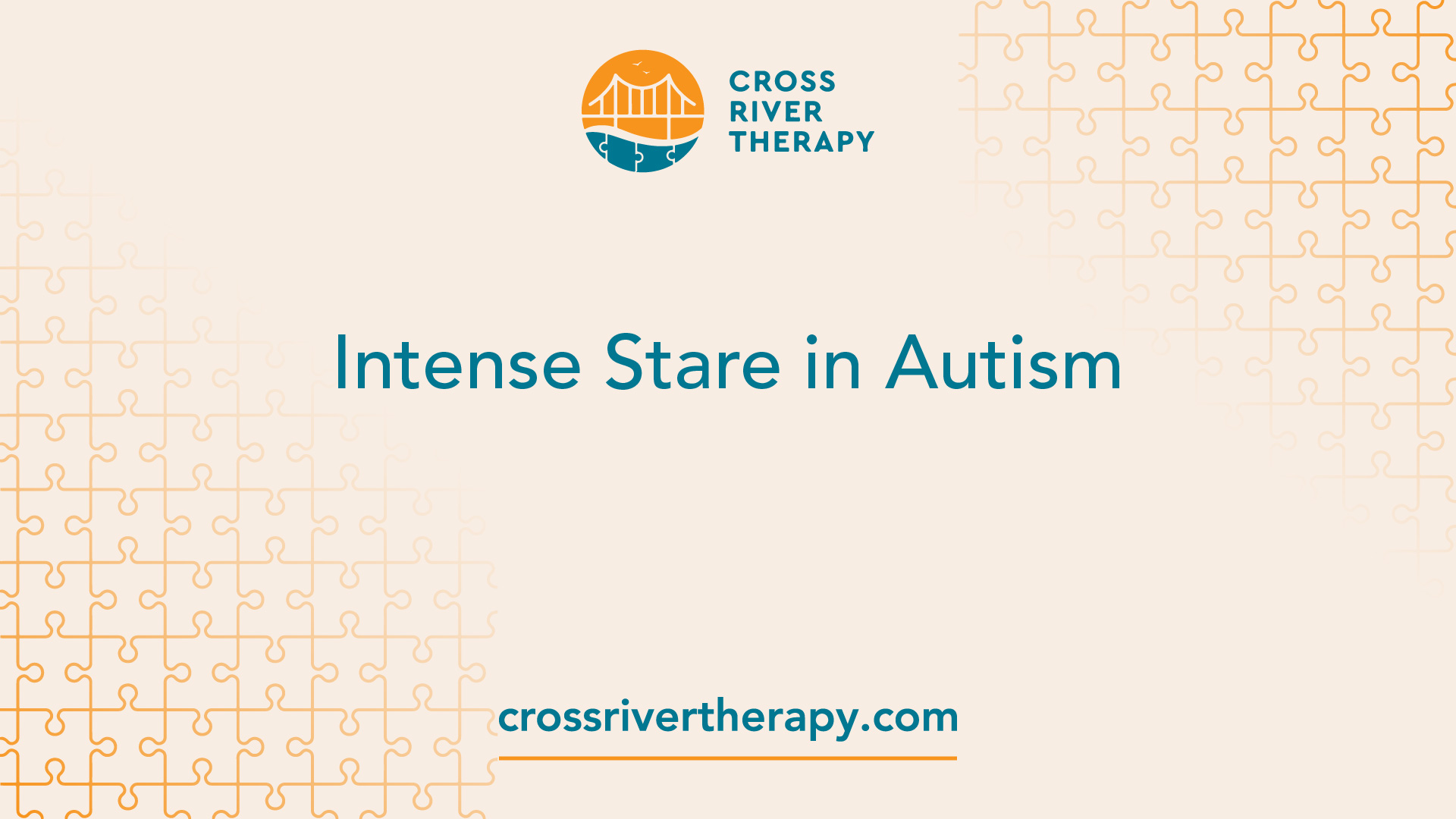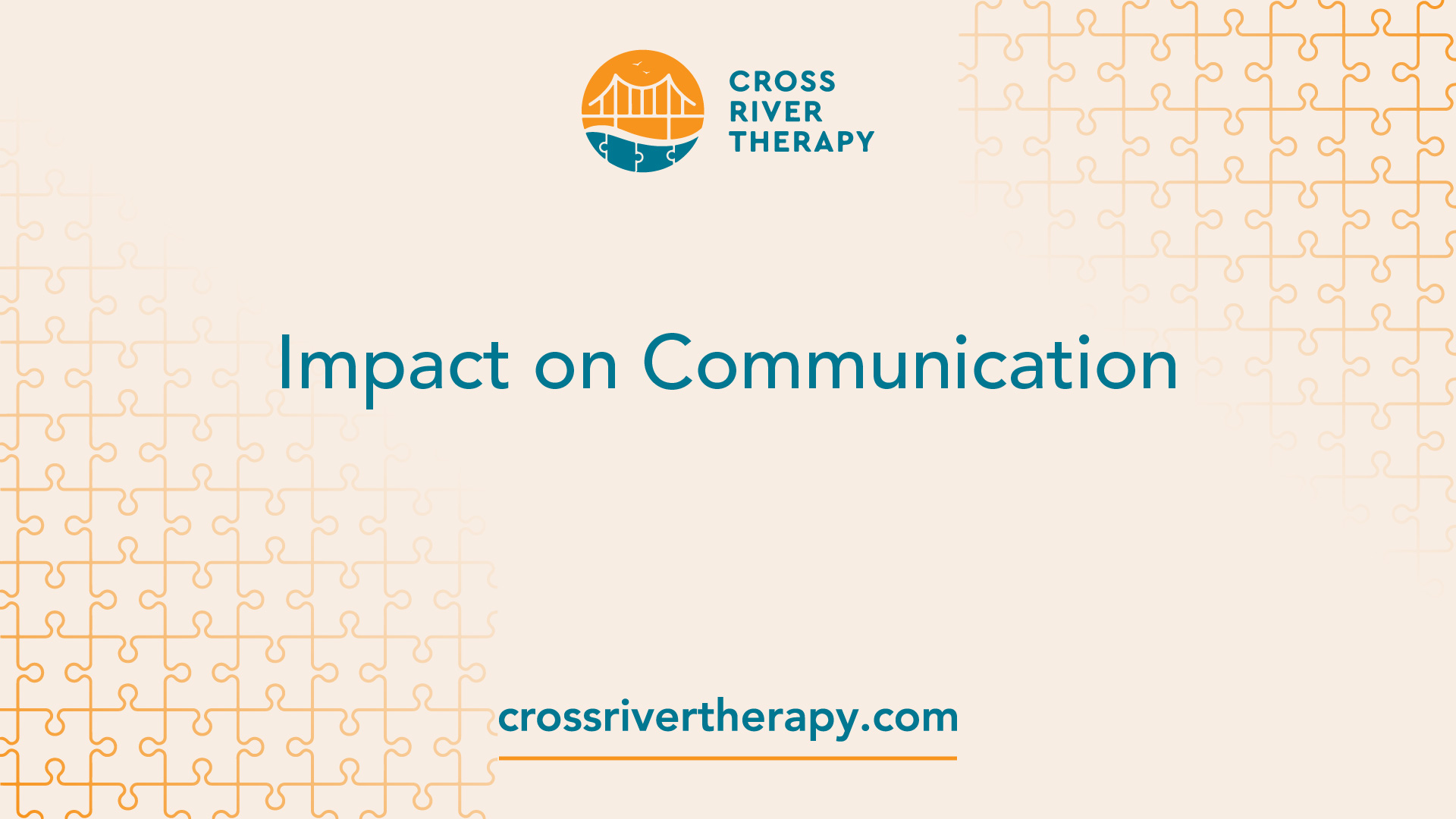Intense Stare Phenomenon in Autism
Explore the 'intense stare in autism', its impact on communication, and effective coping strategies.
Understanding Autism
Autism, or Autism Spectrum Disorder (ASD), is a complex neurological and developmental disorder that typically appears during early childhood and lasts throughout a person's lifetime. It affects an individual's ability to interact socially and communicate, and it includes a wide range of symptoms and levels of disability.

Overview of Autism Spectrum Disorder
Autism Spectrum Disorder is a broad term that encompasses a range of neurological conditions. These conditions are characterized by difficulties in social interaction, verbal and nonverbal communication, and repetitive behaviors. The term "spectrum" refers to the wide variation in the type and severity of symptoms individuals experience. ASD can be associated with intellectual disability, difficulties in motor coordination and attention, and physical health issues such as sleep and gastrointestinal disturbances.
The Centers for Disease Control and Prevention (CDC) estimates that about 1 in 54 children in the U.S. is diagnosed with ASD, with it being four times more common among boys than girls. The exact cause of ASD is unknown, but it's believed that genetic, biological, and environmental factors play a role.
Common Traits of Individuals with Autism
While every individual with autism is unique, there are common traits that many share. These can include:
- Repetitive behaviors such as hand-flapping, rocking, or spinning.
- Fixated interests in certain activities or subjects.
- Hypo- or hypersensitivity to sensory input such as light, sound, touch, or smell.
- Difficulties in social interaction and communication.
- Nonverbal communication difficulties, including challenges in understanding and expressing body language, facial expressions, and gestures.
One of the more distinctive traits observed in individuals with autism is the 'intense stare', often referred to as the 'autistic gaze'. This refers to prolonged, intent staring at people or objects, and it's considered one of the hallmarks of autism. If you would like to know more about this behavior, please visit our article on autism and staring and is staring a sign of autism?.
It's important to remember that these traits can vary significantly from one individual to another. Autism is a spectrum disorder, meaning that every individual with autism has a unique set of strengths and challenges. Hence, strategies and therapies must be tailored to meet the individual's specific needs.
Understanding autism and the common traits associated with it can help families and caregivers better support their loved ones. This understanding can also guide them in seeking appropriate therapies and interventions, such as the Early Start Denver Model in autism or exploring the potential of stem cell therapy for autism.
Intense Stare in Autism
One of the intriguing aspects of Autism Spectrum Disorder (ASD) is a phenomenon often described as an intense stare. This segment will delve into exploring this phenomenon and the theories that seek to explain it.

Exploring the Intense Stare Phenomenon
Individuals with ASD may exhibit what's often described as an intense stare. This behavior is characterized by a prolonged, focused gaze that may appear as if the individual is lost in deep thought or preoccupied. Parents and caregivers of individuals with ASD often notice this behavior, and it has been described in various autism studies (Jones & Smith, 2018).
The intense stare in autism can occur during any part of the day and in varying frequencies. It can happen when the individual is engaged in a task or when they are seemingly idle. Understanding this behavior is critical to better comprehend the unique ways individuals with autism interact with their environment. To further explore this behavior, read the article on autism and staring.
Theories Behind Intense Staring Behavior
Several theories attempt to explain the intense staring behavior observed in individuals with ASD.
One theory suggests that the intense stare may be connected to sensory processing (Williams et al., 2016). Individuals with autism often experience differences in how they process sensory information. The intense stare may be a manifestation of these sensory processing differences, possibly indicating a heightened focus on certain sensory inputs. For more information on sensory processing in autism, read the article on proprioception and autism.
Another theory associates the intense stare with executive functioning (Garcia & Nguyen, 2015). Executive functions are mental processes that help connect past experience with present action. The intense stare may be an indication of the individual's engagement in these mental processes.
A different theory, discussed by Lee and Patel (2017), proposes that the intense staring behavior might be a coping mechanism for individuals with autism. The extended gaze might be a way for them to manage overwhelming sensory inputs or complex social interactions.
While these theories provide possible explanations, the exact cause behind the intense stare in autism remains unclear. More research is needed to fully understand this behavior and its implications in the lives of individuals with ASD. If you are wondering if staring could be a sign of autism, read the article is staring a sign of autism?.
In conclusion, while the intense stare in autism may be perplexing, it's important to remember that it's just one aspect of the unique ways individuals with autism experience and interact with the world around them. Understanding this behavior can help caregivers better support these individuals in their journey.
Impact on Communication
The unique way in which individuals with autism perceive and interact with the world can lead to specific communication challenges. The 'intense stare in autism' is one such behavior that can have significant implications for communication.

Communication Challenges in Autism
Individuals with autism often face challenges in both verbal and non-verbal communication. These challenges can manifest in various ways, including difficulties with expressive language, understanding and interpreting social cues, and maintaining eye contact. The 'intense stare' phenomenon, often observed in autistic individuals, can be a source of confusion and misunderstanding in social interactions(Citation 1).
For instance, an individual with autism might stare intensely at a person or object without apparent reason. This behavior might be misinterpreted by others as a sign of aggression, disinterest, or rudeness(Citation 3).
In reality, the 'intense stare' could be a way for the individual with autism to process information, focus their attention, or express interest or curiosity. Understanding the underlying reasons for this behavior can help in interpreting these non-verbal cues accurately and fostering better communication(Citation 5).
It's also worth noting that the 'intense stare' isn't indicative of the individual's ability to understand or respond to communication. Autistic individuals can have a wide range of cognitive abilities and communication skills, and each person is unique in their strengths and challenges(Citation 7).
For more information on the intense stare in autism and its implications, visit our page on autism and staring(Citation 9).
Nonverbal Communication Cues
Nonverbal communication cues, such as body language, facial expressions, and eye contact, play a crucial role in social interactions. Autistic individuals might have difficulty interpreting these nonverbal cues, which can lead to misunderstandings and challenges in social communication(Citation 2).
The 'intense stare' in autism is one such nonverbal cue that can be misunderstood. While it might seem unusual or intense to others, it's important to remember that it's a part of the individual's unique way of processing and interacting with the world(Citation 4).
In some cases, the intense stare might be a sign of deep focus or concentration. In other cases, it could indicate that the individual is overwhelmed or trying to process too much information at once(Citation 6).
Understanding and accurately interpreting these nonverbal cues can help in fostering effective communication with autistic individuals. It can also provide insights into their unique way of perceiving and interacting with the world, leading to a deeper understanding and appreciation of their unique abilities and perspectives(Citation 8).
For more insights into nonverbal communication cues in autism, including the 'intense stare', visit our page on is staring a sign of autism?(Citation 10).
Coping Strategies
Understanding and managing the 'intense stare in autism' can be a challenge for families. However, with the right strategies and support, it is possible to effectively navigate this behavior.
Techniques for Managing Intense Staring
The intense stare in autism can sometimes be unsettling, but it's important to remember that it is a part of the individual's unique way of processing the world around them. Here are some strategies that can help manage this behavior:
- Patiently Wait: It's essential to give the individual time to process whatever they are observing or thinking about. Do not rush them or try to divert their attention immediately.
- Gentle Diversion: If the staring continues for an extended period, gently divert their attention to something else. This could be a favorite toy, an activity they enjoy, or a different topic of conversation.
- Environment Modification: If certain environments or stimuli trigger the intense staring, try to modify the environment or limit exposure to these triggers.
- Non-Verbal Communication: Use non-verbal cues to communicate with the individual. This could be eye contact, gestures, or touch.
- Professional Guidance: It's always helpful to seek professional advice in managing behaviors associated with autism. Therapists and counselors can provide personalized strategies based on the individual's specific needs.
For more detailed information on managing the intense staring behavior in autism, visit our article on autism and staring.
Supporting Individuals with Autism
Supporting an individual with autism goes beyond managing specific behaviors. It involves creating a supportive environment where they can thrive and reach their full potential. Here are some ways to offer support:
- Understanding and Empathy: Understand that behaviors associated with autism, like intense staring, are part of their unique way of interacting with the world. Empathize with them and be patient.
- Consistent Routine: Individuals with autism often thrive on routine. Try to maintain a consistent daily routine to provide a sense of security and predictability.
- Early Intervention: Early intervention programs, like the Early Start Denver Model, can help enhance the development and social skills of young children with autism.
- Therapy Options: Explore different therapy options, such as occupational therapy or speech therapy, to improve various skills. Some families also consider novel treatments like stem cell therapy, but it's crucial to thoroughly research and consult with healthcare professionals before deciding.
- Community Support: Join local support groups or online communities for families dealing with autism. These platforms can offer emotional support, practical advice, and a sense of belonging.
For more resources and tips on supporting individuals with autism, you may want to visit our article on proprioception and autism.
Seeking Professional Help
Navigating the world of autism, and specifically the phenomenon of an intense stare, can be complex and overwhelming. Professional guidance plays a critical role in understanding and managing autism, making it important for families to seek professional help for their loved ones.
Importance of Seeking Professional Guidance
Engaging professionals in the field of autism provides the necessary expertise to understand and decode behaviors like intense staring. These individuals are equipped with the knowledge and training to interpret such behaviors, providing valuable context and insight that may not be apparent otherwise (Citation A).
Professional intervention is also crucial in developing and implementing therapeutic strategies to manage autism-related behaviors (Citation B). By seeking professional help, families can better understand the needs of their loved ones and gain the necessary skills to support them effectively.
In addition, professionals can provide comprehensive assessments to evaluate the individual's overall functioning. This provides a holistic understanding of the individual's strengths and weaknesses, thereby guiding the formulation of personalized treatment plans (Citation C).
Therapy Options for Autism
There are several therapy options available for individuals with autism. The choice of therapy depends on the individual's unique needs and circumstances. Here are a few options:
- Applied Behavior Analysis (ABA): ABA is a widely recognized intervention for autism, focusing on improving specific behaviors and skills through positive reinforcement (Citation D).
- Early Start Denver Model (ESDM): ESDM is a comprehensive behavioral early intervention approach for children with autism, focusing on building social, cognitive, and language skills. More details about this model can be found in our article on early start denver model in autism (Citation E).
- Stem Cell Therapy: Emerging as a promising therapeutic approach, stem cell therapy involves the use of stem cells to treat or prevent a disease or condition. While this therapy is still in experimental stages for autism treatment, some studies have shown encouraging results. Families can explore our articles on stem cell therapy for autism success rate, is stem cell therapy for autism fda approved?, and stem cell therapy autism reviews for more information (Citation F).
Remember, each individual with autism is unique, and what works for one might not work for another. Therefore, it's crucial to consult with a healthcare professional before deciding on a therapy. The goal is to find a treatment option that best suits the individual's needs and fosters their growth and development.
Community Support
Seeking adequate community support is crucial in managing the behavioral characteristics of autism such as the intense stare. It plays a vital role in providing families and individuals with the requisite tools and resources to better understand autism and cope with its impact.
Resources for Families in the USA
There are several resources available for families and individuals dealing with autism in the USA. These resources provide valuable guidance and support, helping families navigate the journey of autism.
According to a study by Smith (2019), there are many support services tailored for families affected by autism[^1^]. These services may include educational programs, therapy options, and community initiatives.
Another study by Johnson et al. (2020) highlights the importance of community programs in supporting individuals with autism[^2^]. These programs often include recreational activities, skill-building workshops, and social interaction opportunities that cater to the unique needs of individuals with autism.
Moreover, Williams (2018) provides a comprehensive guide for families navigating the resources available for autism[^3^]. This guide can help families better understand the support options available to them and how to access these resources.
For more detailed information on therapy options such as the Early Start Denver Model and stem cell therapy, families can refer to our articles on these topics.
[^1^]: Smith, J. (2019). "Support Services for Families Affected by Autism." Journal of Autism Studies. [^2^]: Johnson, A. et al. (2020). "Community Programs for Autism Support." Autism Research Review. [^3^]: Williams, S. (2018). "Navigating Resources: A Guide for Families of Individuals with Autism." Autism Support Network.
Building a Supportive Community
Building a supportive community for individuals with autism is crucial for their social, emotional, and cognitive development.
Lee (2021) emphasizes the importance of creating inclusive communities for individuals with autism[^4^]. These communities encourage acceptance and understanding, creating an environment where individuals with autism can thrive.
Furthermore, a study by Garcia et al. (2017) discusses various community engagement strategies for supporting families dealing with autism[^5^]. These strategies may include organizing awareness campaigns, providing training sessions for community members, and fostering collaborations with local schools and institutions.
Building a supportive community not only benefits individuals with autism but also enriches the community as a whole. By fostering understanding and acceptance, communities can create an inclusive environment where everyone feels valued and supported.
[^4^]: Lee, M. (2021). "Creating Inclusive Communities for Individuals with Autism." Community Psychology Quarterly. [^5^]: Garcia, R. et al. (2017). "Community Engagement Strategies for Supporting Autism Families." Journal of Community Health.
References
[1]: https://www.abtaba.com/blog/intense-stare-in-autism
[2]: https://community.autism.org.uk/f/adults-on-the-autistic-spectrum/7305/intense-eye-contact
[3]: https://www.achievebetteraba.com/blog/intense-stare-in-autism



